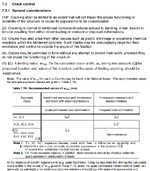CJLCivilStruct
Structural
Just wondering what the general consensus is for calculating crack widths in RC foundation design - think ground beams, rafts and pads.
I have always calculated and limited the crack widths to 0.3mm for exposure classes XC3/4 for durability.
However, I sometimes come across examples of ground beam designs for example where crack widths aren't considered at all. Is this lazy design or generally what Engineers tend to do given its in the ground and more than likely not to be seen again?
Given that quite often for me the majority of the loading in foundation design is quasi-permanent, I find that crack control typically governs and results in an extra 20/30% area of steel required. Am I being over conservative?!
Anyway, I hope this is a good topic of discussion. Thanks in advance.
I have always calculated and limited the crack widths to 0.3mm for exposure classes XC3/4 for durability.
However, I sometimes come across examples of ground beam designs for example where crack widths aren't considered at all. Is this lazy design or generally what Engineers tend to do given its in the ground and more than likely not to be seen again?
Given that quite often for me the majority of the loading in foundation design is quasi-permanent, I find that crack control typically governs and results in an extra 20/30% area of steel required. Am I being over conservative?!
Anyway, I hope this is a good topic of discussion. Thanks in advance.

